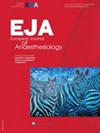Mean arterial pressure versus cardiac index for haemodynamic management and myocardial injury after hepatopancreatic surgery: A randomised controlled trial.
IF 4.2
2区 医学
Q1 ANESTHESIOLOGY
引用次数: 0
Abstract
BACKGROUND Myocardial injury after noncardiac surgery (MINS) frequently complicates the peri-operative period and is associated with increased mortality. OBJECTIVES We hypothesised that cardiac index (CI) based haemodynamic management reduces peri-operative high-sensitive troponin-T (hsTnT) elevation and MINS incidence in patients undergoing hepatic/pancreatic surgery compared to mean arterial pressure. DESIGN A randomised controlled study. SETTING A single-centre study conducted in a university-affiliated tertiary hospital between June 2022 and March 2023. PATIENTS Ninety-one patients, who were ≥ 65 years old or ≥ 45 years old with a history of at least one cardiac risk factor were randomised to either mean arterial pressure (MAP) based (n = 45) or CI-based (n = 46) management groups, and completed the study. INTERVENTIONS In group-MAP, patients received fluid boluses and/or a noradrenaline infusion to maintain MAP above the predefined threshold. In group-CI, patients received fluid boluses and/or dobutamine infusion to keep CI above the predefined threshold. When a low MAP was observed despite a normal CI, a noradrenaline infusion was started. MAIN OUTCOME MEASURES The primary outcome was peri-operative hsTnT elevation. The secondary outcomes were MINS incidence and 90-day mortality. RESULTS The median absolute troponin elevation was 4.3 ng l-1 (95% CI 3.4 to 6) for the CI-based group, and 9.4 ng l-1 (95% CI 7.7 to 12.7) for the MAP-based group (median difference: 5.1 ng l-1, 95% CI 3 to 7; P < 0.001). MINS occurred in 8 (17.4%) patients in the CI-based group and 17 (37.8%) patients in the MAP-based group (relative risk: 0.46, 95% CI: 0.22 to 0.96; P = 0.029). Two patients in group-MAP died from cardiovascular-related causes. One patient in group-CI and two in group-MAP died from sepsis-related complications (for all-cause mortality: χ2 = 1.98, P = 0.16). MAP-AUC and CI-AUC values of the CI- and MAP-based groups were 147 vs. 179 min × mmHg (P = 0.85) and 8.4 vs. 43.2 l m-2 min-1 × min (P < 0.001), respectively. CONCLUSIONS CI-based haemodynamic management assures sufficient flow and consequently is associated with peri-operative hsTnT elevation and the incidence of MINS compared to MAP. TRIAL REGISTRATION Clinicaltrials.gov identifier: NCT05391087.肝胰腺手术后血流动力学管理和心肌损伤方面的平均动脉压与心脏指数对比:随机对照试验。
背景非心脏手术后心肌损伤(MINS)经常使围手术期变得复杂,并与死亡率增加有关。目的我们假设,与平均动脉压相比,基于心脏指数(CI)的血流动力学管理可降低肝脏/胰腺手术患者围手术期高敏肌钙蛋白-T(hsTnT)升高和 MINS 发生率。设置2022年6月至2023年3月期间在一所大学附属三级医院进行的单中心研究。患者91名年龄≥65岁或≥45岁且至少有一个心脏风险因素病史的患者被随机分配到基于平均动脉压(MAP)(n = 45)或基于CI(n = 46)的管理组,并完成研究。干预在 MAP 组,患者接受液体注射和/或去甲肾上腺素输注,以将 MAP 维持在预定阈值以上。在 CI 组中,患者接受液体注射和/或多巴酚丁胺输注,以将 CI 维持在预定阈值以上。主要结局测量主要结局是围手术期 hsTnT 升高。结果基于 CI 组的绝对肌钙蛋白升高中位数为 4.3 纳克/升(95% CI 3.4 至 6),基于 MAP 组的绝对肌钙蛋白升高中位数为 9.4 纳克/升(95% CI 7.7 至 12.7)(中位数差异:5.1 纳克/升,95% CI 3 至 7;P < 0.001)。基于 CI 的组别中有 8 名患者(17.4%)发生 MINS,基于 MAP 的组别中有 17 名患者(37.8%)发生 MINS(相对风险:0.46,95% CI:0.22 至 0.96;P = 0.029)。MAP 组中有两名患者死于心血管相关原因。CI组和MAP组分别有一名和两名患者死于脓毒症相关并发症(全因死亡率:χ2 = 1.98,P = 0.16)。结论与 MAP 相比,CI 组和 MAP 组的 MAP-AUC 和 CI-AUC 值分别为 147 vs. 179 min × mmHg(P = 0.85)和 8.4 vs. 43.2 l m-2 min-1 × min(P < 0.001).TRIAL REGISTRATIONClinicaltrials.gov identifier:NCT05391087。
本文章由计算机程序翻译,如有差异,请以英文原文为准。
求助全文
约1分钟内获得全文
求助全文
来源期刊
CiteScore
6.90
自引率
11.10%
发文量
351
审稿时长
6-12 weeks
期刊介绍:
The European Journal of Anaesthesiology (EJA) publishes original work of high scientific quality in the field of anaesthesiology, pain, emergency medicine and intensive care. Preference is given to experimental work or clinical observation in man, and to laboratory work of clinical relevance. The journal also publishes commissioned reviews by an authority, editorials, invited commentaries, special articles, pro and con debates, and short reports (correspondences, case reports, short reports of clinical studies).

 求助内容:
求助内容: 应助结果提醒方式:
应助结果提醒方式:


